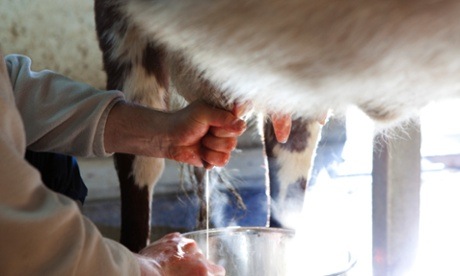
Health experts have warned Victorians not to take part in a raw-milk drinking stunt planned in Melbourne at the weekend.
The Australian Raw Milk Movement is encouraging people to “BYO cup” and drink raw milk outside the office of the consumer affairs minister, Jane Garrett, on Saturday to protest against new laws requiring raw bath or cosmetic milk to be pasteurised, or mixed with a gag-inducing substance, before sale.
It is already illegal to sell raw milk for human consumption in Australia because of the risk of pathogens, but some consumers drink the cosmetic “bath milk”, which is packaged like regular milk.
The laws were tightened after a three-year-old child died and four others became seriously ill after drinking raw milk sold as bath milk.
A leading infectious disease physician and microbiologist, Professor Peter Collignon, said he was concerned by the drink-in, and that uninformed people may try the product thinking “raw” also meant “healthy”.
“I would advise no one to participate,” he said.
“There is a lot of evidence you can get a lot of harm from raw milk, and the basic problem is that the milk comes from the udders, close to where germs from fecal material live.
“A lot of germs like salmonella are found near udders, and that gets into the milk. Diseases like tuberculosis and brucella were transmitted through milk until pasteurisation became mandatory, which kills the germs through heating.”
He described pasteurisation as a public health breakthrough, and said he was unaware of any strong evidence of health benefits associated with drinking raw milk.
Some people who preferred raw milk believed it tasted better, he said.
“But heating doesn’t do much to change quality of proteins found in milk, so even after pasteurisation you’re still getting the nutritional benefits. People who believe raw milk is healthier, well, they’re not looking at the evidence, and they’re placing themselves at huge risk for a marginal benefit.”
He was concerned organisers of the drink-in would not inform participants of the risks.
“If they try to say to people raw milk is more pure they are wrong and are trying to get people to do something dangerous,” he said.
Guardian Australia contacted Garrett’s office for comment and a spokesman said they were aware of the planned protest.
In December Victoria’s chief health officer, Dr Rosemary Lester, issued a warning about the dangers of drinking raw cow’s milk.
A spokesman for Lester told Guardian Australia on Thursday she stood by that warning.
“Giving people the false impression raw milk is safe is not only potentially injurious to health, it is inappropriate,” the spokesman said.
The organiser of the drink-in, Rebecca Freer, who runs the Australian Raw Milk Movement, said she was “well-informed”.
“It’s our consumer right to define what we eat and drink,” she said. “Australia is really backwards on this issue.”
